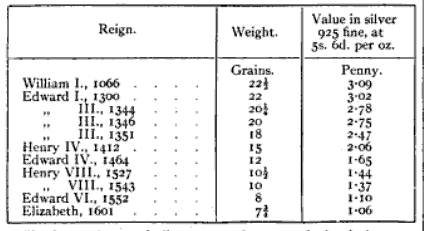Penny
PENNY (Mid. Eng. peni or peny, from O. Eng. form penig, earlier penning and pending; the word appears in Ger. Pfennig and Du. penning; it has been connected with Du. pand, Ger. Pfand, and Eng. "pawn," the word meaning a little pledge or token, or with Ger. Pfanne, a pan). An English coin, equal in value to the one-twelfth of a shilling. It is one of the oldest of English coins, superseding the sceatta or sceat (see NUMISMATICS; and BRITAIN: Anglo Saxon, § "Coins"). It was introduced into England by Offa, king of Mercia, who took as a model a coin first struck by Pippin, father of Charlemagne, about 735, which was known in Europe as novus denarius. Offa's penny was made of silver and weighed 22.5 grains, 240 pennies weighing one Saxon pound (or Tower pound, as it was afterwards called), hence the term pennyweight (dwt.). In 1527 the Tower pound of 5400 grains was abolished, and the pound of 5760 grains adopted instead. The penny remained, with some few exceptions, the only coin issued in England until the introduction of the gold florin by Edward III. in 1343. It was not until the reign of Edward I. that halfpence and farthings became a regular part of the coinage, it having been usual to subdivide the penny for trade purposes by cutting it into halves and quarters, a practice said to have originated in the reign of AEthelred II. In 1257, in the reign of Henry III., a gold penny, of the value of twenty silver pence, was struck. The weight and value of the silver penny steadily declined from 1300 onwards, as will be seen from the following table:

The last coinage of silver pence for general circulation was in the reign of Charles II. (1661-1662), since which time they have only been coined for issue as royal alms on Maundy Thursdays. Copper halfpence were first issued in Charles II.'s reign, [1] but it was not until 1797, in the reign of George III., that copper pence were struck. This copper penny weighed 1 oz. avoirdupois. In the same year copper twopences were issued weighing 2 oz., but they were found too cumbersome and were discontinued. In 1860 bronze was substituted for the copper coinage, the alloy containing 95 parts of copper, 4 of tin, and 1 of zinc. The weight was also reduced, 1 Ib of bronze being coined into 48 pennies, as against 24 pennies into which 1 lb of copper was coined.
[1] The figure of Britannia first appeared on this issue of copper coins. The original of Britannia is said to have been Frances Stewart, afterwards duchess of Richmond (Pepys, Diary, Feb. 25, 1667). It was in Charles II.'s reign, too, that the practice was established of placing the sovereign's bust in a direction contrary to that of his predecessor.
Penny - Further reading (external links)
Silver Penny
Gold Penny
Gold Florin

Note - this article incorporates content from Encyclopaedia Britannica, Eleventh Edition, (1910-1911)


